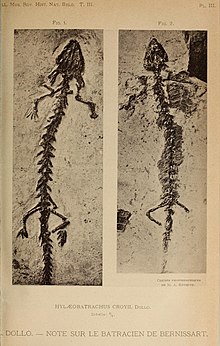Hylaeobatrachus is an extinct genus of prehistoric salamander, known from the Early Cretaceous of Europe.[1][2] The type species H. croyii is known from the Sainte-Barbe Clays Formation at the Iguanodon locality of Belgium, and was described by Louis Dollo. An unnamed Hylaeobatrachus-like taxon has also been reported from Las Hoyas, Spain. Both localities are of Barremian age.[3] Hylaeobatrachus belongs to the crown group of modern salamanders, though its exact relationship with modern salamander groups is uncertain. It was neotenic, llike some modern salamanders.[4]
| Hylaeobatrachus Temporal range:
| |
|---|---|

| |
| Slab and counterslab of holotype specimen | |
| Scientific classification | |
| Domain: | Eukaryota |
| Kingdom: | Animalia |
| Phylum: | Chordata |
| Class: | Amphibia |
| Clade: | Caudata |
| Genus: | †Hylaeobatrachus Dollo, 1884 |
| Type species | |
| † Hylaeobatrachus croyii Dollo, 1884
| |
See also edit
References edit
- ^ "†Hylaeobatrachus Dollo 1884". Paleobiology Database. Fossilworks. Retrieved 12 April 2018.
- ^ Martín, C.; Sanchiz, B. (2014). "Hylaeobatrachus Dollo, 1884". Lisanfos KMS. Version 1.2. Online reference accessible at www.lisanfos.mncn.csic.es/. Museo Nacional de Ciencias Naturales, MNCN-CSIC, Madrid (Spain). Archived from the original on 24 February 2014. Retrieved 21 February 2014.
- ^ Skutschas, Pavel P.; Kolchanov, Veniamin V.; Schwermann, Achim H. (December 2020). "First salamander from the Lower Cretaceous of Germany". Cretaceous Research. 116: 104606. doi:10.1016/j.cretres.2020.104606. S2CID 225440583.
- ^ Jones, Marc E. H.; Benson, Roger B. J.; Skutschas, Pavel; Hill, Lucy; Panciroli, Elsa; Schmitt, Armin D.; Walsh, Stig A.; Evans, Susan E. (2022-07-26). "Middle Jurassic fossils document an early stage in salamander evolution". Proceedings of the National Academy of Sciences. 119 (30): e2114100119. doi:10.1073/pnas.2114100119. ISSN 0027-8424. PMC 9335269. PMID 35858401.